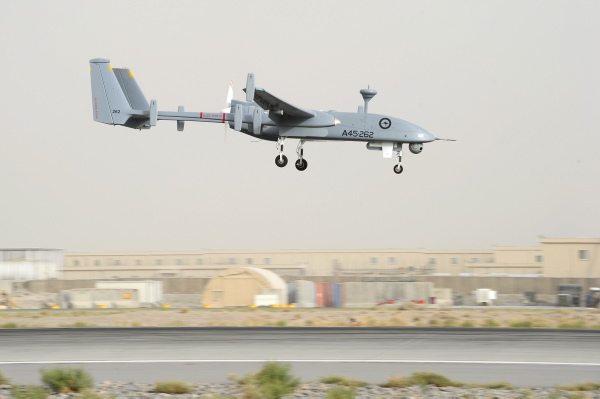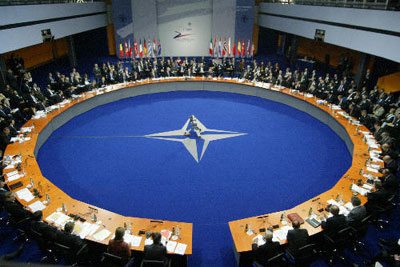In recent years, unmanned aerial systems have been playing an increasingly important role in military operations worldwide. Many of the sensors used in modern network-enabled operations are mounted on drones, i.e. unmanned aerial vehicles (UAVs) or remotely piloted vehicles (RPVs); in addition, modern armed forces are using them more and more often as effector platforms.
Under its SAATEG programme, which stands for “Systems zur Abbildenden Aufklärung in der Tiefe des Einsatzgebietes” or “Systems for imagery reconnaissance deep in the area of operations”, the Bundeswehr is cooperating closely with Rheinmetall Defence of Germany and its partner company Israel Aerospace Industries Ltd. (IAI). The globally operating Israeli enterprise has over forty years’ experience in the international defence industry and some 17,000 employees. In total, IAI-made UAS products have already clocked on around 900,000 flight hours. Joint Rheinmetall and IAI projects now help to protect German and allied troops deployed in harm’s way in Afghanistan and elsewhere.
SAATEG intermediate solution – Heron 1
Under a service contract with the Bundeswehr, Rheinmetall and IAI have been operating the highly advanced Heron 1 reconnaissance system in Afghanistan since March 2010. An interim SAATEG solution, it decisively enhances the Bundeswehr’s intelligence gathering and reconnaissance capabilities in Afghanistan. It is the first unmanned aircraft ever to operate under the aegis of the German Air Force.
Rheinmetall partner IAI supplies the system, the Heron 1, which is already operated by other allied nations in Afghanistan. This unmanned asset is a medium-altitude long endurance (MALE) aircraft that can operate around the clock, around the world in almost all weathers. Equipped with state-of-the-art imaging sensors, the Heron 1 forms an integral part of the C4I loop, transmitting imagery in real time and making it perfect for surveillance and reconnaissance missions, identification and acquisition of stationary and moving targets and post-strike evaluation. Thanks to its satellite data link, the Heron 1 is able to transmit full motion video information over long distances, while its imaging radar produces excellent reconnaissance results in real time even in conditions of poor visibility.
A typical SAATEG mission lasts 16 hours, though it has also operated for up to 27 hours at a stretch.
To date, the SAATEG interim solution has flown over 4,000 hours in Afghanistan, including 600 in May 2011 alone – over a hundred more than contractually agreed, representing an average of twenty hours a day. At the end of May, the German Air Force’s top-ranking general declared the Heron 1 squadron based in Mazar-e-Sharif to be fully operational.
Requests from other nations underscore the high quality of the reconnaissance results. In the meantime, hardly any ground operations take place without UAS support. Equally remarkable was the short time it took to get the SAATEG interim solution up and running, with not quite five months elapsing between award of the contract and the first flight in Afghanistan.
In this brief timeframe, Rheinmetall and IAI put together a maintenance and logistical support organization and obtained the necessary airworthiness certification for an unmanned aircraft. In order to operate the system for the German Air Force according to contract and to assure round-the-clock support services, Rheinmetall made some 40 qualified aircraft mechanics and pilots available, arranging for them to be trained – together with German Air Force personnel assigned to the mission – at IAI in Israel to operate and maintain the new system.
The Heron systems also had to be built and transported to Afghanistan during this period.
Given its positive experience with the system, the Bundeswehr opted to extend the original one-year service contract for a further two years.
Furthermore, the German Air Force is reviewing ways of enhancing its performance.
SAATEG follow-on solution – Heron TP
In response to the Bundeswehr’s requirement for a follow-on solution for SAATEG starting in 2013, Rheinmetall has put forward the Heron TP (TP stands for turboprop). An advanced version of the Heron 1, the Heron TP is ready to go into operation right away. With a wingspan of 26 metres and a maximum take-off weight of 5,000 kilos, this 14-metre-long UAV can carry a payload of up to 1,000 kilos.
Its engine output is approximately 900 KW (around 1,200 horsepower). It has an operating ceiling of 45,000 feet (14,800 metre), higher than that of a civilian aircraft. Moreover, the Heron TP can operate in all weathers and climate zones, and be airlifted into any area of operations in an Airbus A 400 M military transport plane. This cutting edge system can remain in the air for over 36 hours.
Technologically speaking, the Heron TP represents the state of the art as well as offering robust scope for growth, especially with respect to payload. National sensor systems can be easily integrated into the aircraft.
Today the Heron TP already meets the full range of requirements for a future MALE reconnaissance system. It will be available faster, cost less and pose fewer risks than a newly developed aircraft. To a large extent, the system will be modified and produced in Germany, meaning that it will make a major contribution to national know-how in this field. Thus, particularly with respect to the air vehicle, there is no risky development work involved, since the principle challenges lie in improving the sensor chain as well as data preparation.
KZO
Developed for the Bundeswehr, the KZO reconnaissance system has come through its baptism of fire with flying colours. Deployed in Afghanistan since July 2009, by late May 2011 it had already flown nearly 600 missions.
Like the Heron 1, the KZO has added significantly to the Bundeswehr’ intelligence-gathering and reconnaissance capabilities. The tactical commander on the ground has a reconnaissance asset at his disposal that is ready for action 24/7 and can be used, for example, for watching over convoys or searching for explosive devices concealed on patrol routes. It is able to operate at ranges of over 100 kilometres and transmit imagery in real time, making it possible to detect, identify and locate targets with extreme precision. The KZO thus bridges a critical capabilities gap when it comes to protecting friendly forces and the civilian population.
In order to further enhance the system’s reconnaissance performance, Rheinmetall has developed a bi-spectral sensor head at its own initiative. Besides a higher-resolution thermal imaging device, it now features a high-performance daylight camera as well. Some systems are already being retrofitted with the new sensor head. Furthermore, the system’s operating range is being increased to 140 km.
WABEP
Even the best sensors are useless without robust, dependable, rapidly deployable weapon systems. For this reason Rheinmetall has developed a system of systems known by its German acronym WABEP, which stands for “Wirkmittel zur Abstandsfähigen Bekämpfung von Einzel- und Punktzielen”, or “Weapon for standoff engagement of individual and point targets”.
In this networked system, the KZO supplies reconnaissance and post-strike battle damage assessment capabilities. It is accompanied by the Harop attack drone, which is made by Rheinmetall’s tried-and-tested partner IAI. Characterized by an extended loitering capability, the Harop is able to take out high-value targets with extreme precision, speed and tactical flexibility. Because it is possible to abort the mission just moments before the target is hit, the WABEP is also suitable for peace enforcement missions where avoiding collateral damage is imperative. Equipped with a new sensor payload and teamed with the Harop attack drone, the KZO’s capabilities have been given a decisive boost.
Wide-ranging competencies
Rheinmetall has extensive experience in integrating sensors, effectors and C4I assets into networked systems of systems. But the Group’s expertise extends far beyond mere system integration. A certified aviation company authorized to develop, manufacture and maintain aircraft, Rheinmetall has the know-how necessary for pushing forward the certification process for new systems. It also has longstanding experience with procurement processes, logistics, maintenance and the subsequent supply of spare parts.











